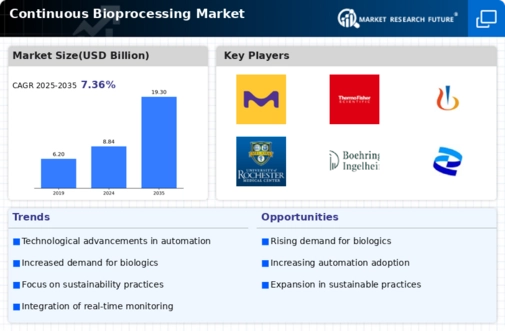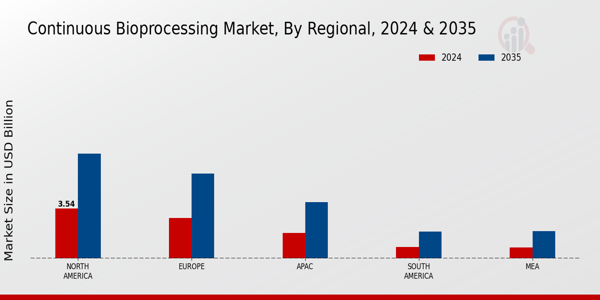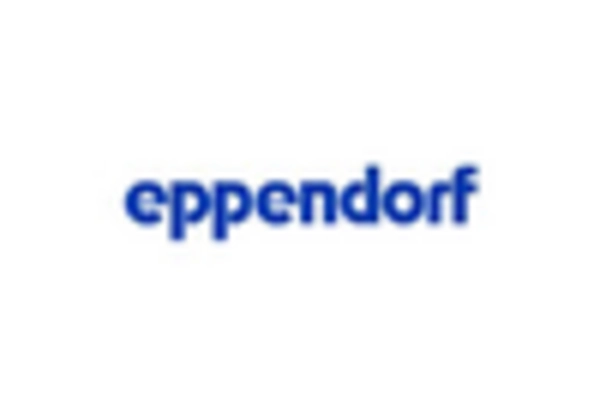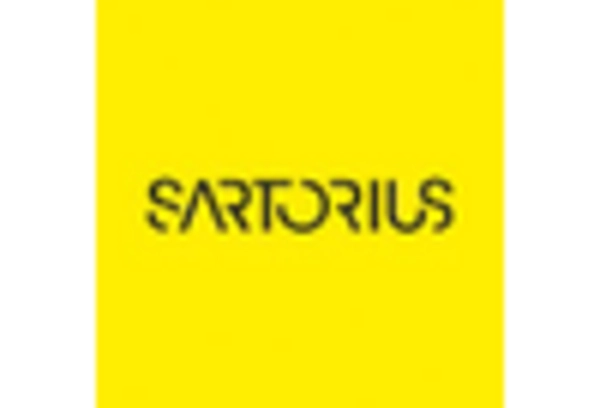Regulatory Support and Frameworks
Regulatory bodies are increasingly recognizing the advantages of continuous bioprocessing, which is driving the Continuous Bioprocessing Market. The establishment of supportive regulatory frameworks facilitates the adoption of continuous processes in biomanufacturing. For instance, agencies have begun to provide guidelines that encourage the implementation of continuous manufacturing technologies, which can lead to improved product quality and reduced time to market. This regulatory support is crucial, as it not only enhances the credibility of continuous bioprocessing but also encourages investment in innovative technologies. As the industry adapts to these evolving regulations, the Continuous Bioprocessing Market is likely to experience accelerated growth, with companies seeking to align their processes with regulatory expectations.
Rising Demand for Biopharmaceuticals
The increasing demand for biopharmaceuticals is a primary driver of the Continuous Bioprocessing Market. As the healthcare sector evolves, there is a notable shift towards biologics, which are often more effective than traditional pharmaceuticals. This trend is evidenced by the fact that biopharmaceuticals accounted for approximately 30 percent of the total pharmaceutical market in recent years. Continuous bioprocessing offers a streamlined approach to manufacturing these complex products, enhancing efficiency and reducing costs. The ability to produce high-quality biologics at scale is crucial, as the market for biopharmaceuticals is projected to reach over 500 billion dollars by 2025. Consequently, the Continuous Bioprocessing Market is poised to benefit significantly from this growing demand.
Growing Focus on Personalized Medicine
The shift towards personalized medicine is emerging as a significant driver for the Continuous Bioprocessing Market. As healthcare becomes more tailored to individual patient needs, the demand for biopharmaceuticals that can be customized is increasing. Continuous bioprocessing offers the flexibility required to produce small batches of personalized therapies efficiently. This adaptability is essential in a market where the need for rapid response to patient-specific requirements is paramount. The rise of personalized medicine is projected to influence the biopharmaceutical market substantially, with estimates suggesting it could reach over 200 billion dollars by 2025. Consequently, the Continuous Bioprocessing Market stands to gain from this trend, as companies seek to develop and manufacture personalized therapies.
Cost Efficiency and Process Optimization
Cost efficiency remains a pivotal driver for the Continuous Bioprocessing Market. Continuous bioprocessing techniques are designed to optimize production processes, thereby reducing operational costs. By minimizing downtime and maximizing resource utilization, companies can achieve significant savings. Reports indicate that continuous processes can reduce production costs by up to 30 percent compared to traditional batch methods. This financial incentive is particularly appealing in an industry where margins can be tight. As organizations strive to enhance their profitability while maintaining product quality, the Continuous Bioprocessing Market is likely to see increased adoption of these cost-effective solutions.
Technological Innovations in Bioprocessing
Technological innovations are reshaping the landscape of the Continuous Bioprocessing Market. Advances in automation, real-time monitoring, and data analytics are enabling more efficient and reliable bioprocessing operations. These technologies facilitate the integration of continuous processes, allowing for better control over production variables and improved product consistency. The implementation of advanced technologies can lead to a reduction in production cycle times and an increase in yield. As companies invest in these innovations, the Continuous Bioprocessing Market is expected to expand, driven by the need for more sophisticated and efficient manufacturing solutions.


















Leave a Comment